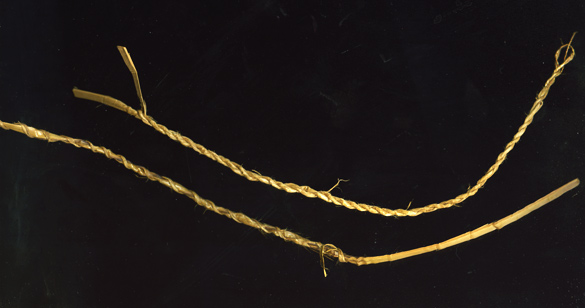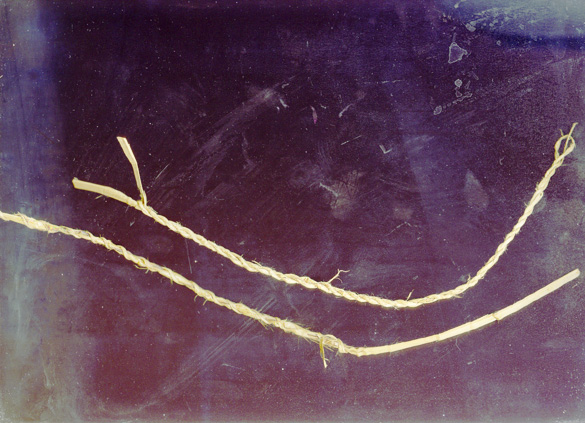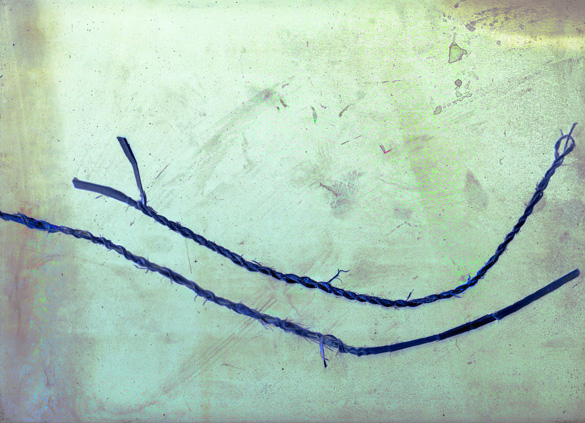cedar twine



At the Squamish Lil’wat Cultural Centre in Whistler, which we visited last month, a guide had taken a group of us around. The end of the tour saw us in a longhouse style activity room where each of us was given a narrow thin strip of previously soaked cedar bark. Following the guide’s instructions we each bent a strip around a peg (one in front of each person) on a long table and firmly twisted one half around the other half, then tied the ends. The top image shows simple samples of what can become the beginnings of complex multi-twisted twine or rope having many purposes, including clothing, hats and baskets.
These pieces have been sitting on my desk for a while so today I felt the urge to do some scanning and image play with them. The images are a bit small to show all details of the fine bark. Especially cool to me was to discover the shocking stains on the scanner bed which emerged when the levels were played with. What fun and who knows, maybe I’ll use these in some work one day.
July 26, 2013 in Being an Artist, Culture, Photoworks, Textures by Marja-Leena
It is always interesting to me how people find things in nature that can be used in beneficial ways.
Dolores, the First Nations people certainly were clever in using what was/is available in nature.
Necessity is the mother of invention. I always much prefer to have restrictions or constraints because I somehow enjoy the problem-solving aspects of art more in those circumstances. I also so love happy accidents like those fascinating backgrounds you have through the state of your scanner. Little things can give so much pleasure.
I love the bottom image, a gorgeous abstract painting in itself. Reminds me of the work of someone but I can’t think of the name – Paul Klee? Twombly?
Anyway what an interesting lesson – I had no idea one could make rope from tree bark.
Surprising that bark can be so supple. Wasn’t the prehistoric man who was found frozen in a glacier in the Alps in Europe wearing some similar fibre? We tend to think of our early ancestors using animal skins for clothing, but plants were in use very early too, it seems.
I rather like your smeary scanner effects!
Olga, necessity and happy accidents sound almost opposite yet really are the tools of artists and craftspeople, aren’t they?
Natalie, that the last two images look like abstract paintings is what excites me. Rather like Twombly and others.
Lucy, it is surprising what our early ancestors could do with tree barks and other plant fibres. Necessity, as Olga wrote. I love the birch bark creations of the Finnish people, such as the birch bark slippers my grandfather wore.
Glad you like the “smeary scanner effects”. The scanner looked clean to me.
Every so often when I’m out walking I’ll notice fast growing reeds and long grasses and rather wish I’d learned to weave little baskets and such. The tactile sense of working with natural materials is a joyful one. Your scans are very cool.
Funny, but I spent some time twisting embroidery floss into pendant cords just a few days ago.
Susan, there you go, lots of native materials one can use to make things! Basket weaving is no longer a necessity but a craft. Cheap imports mean that locally crafted has become expensive. On the other hand, handmade is now even more precious, like the lovely jewelry you are making.
Wonderful stuff twine and rope and the like. The more primitive the better.
Joe, we are in agreement there! Have you ever tried to make your own twine? I made a wee attempt at trying to remove some inner bark from a piece that had fallen off a cedar stump sitting in the garden. Obviously there is some skill and technique needed which I have not explored.
I have often thought it would be worth trying, but only necessity such as being left twine-less on a desert island would I am afraid drive me to it.